Are you curious about the number of calories in white sauce and how it can impact your diet? In this article, I’ll demystify the count and help you make informed choices to stay on track with your goals.
When it comes to counting white sauce calories, it’s essential to be mindful of the fat, sugar, and salt content. Making informed choices can make a significant difference in maintaining a healthy diet while still enjoying the saucy goodness.
- Be aware of the fat, sugar, and salt content in white sauce.
- Opt for reduced-sugar versions or make your own salsa.
- Consider reduced-fat options or make a lighter version using low-fat yogurt for mayonnaise.
- Use soy sauce sparingly, even with reduced-salt versions.
- Create your own sugar-free chili sauce as a healthier alternative to sweet chili sauce.
- Choose reduced-sugar and reduced-salt versions of brown sauce.
- Swap creamy sauces for tomato-based ones to save calories and saturated fat.
- Pair calorie-dense foods with lower-calorie options, such as fruits and vegetables, for a balanced meal.
- Include nutrient-rich low-calorie foods like apples, broccoli, kale, and tomatoes in your diet.
By understanding the impact of white sauce on your calorie intake and making healthier choices, you can continue to enjoy this versatile condiment while staying on track with your diet goals. So, let’s dive into the world of white sauce calories and discover how to make it a delicious yet nutritious addition to your meals!
Understanding White Sauce Calories
To understand the impact of white sauce on your diet, it’s important to know what white sauce calories entail and how different types of white sauce can vary in their calorie count. White sauce, also known as béchamel sauce, is a classic sauce made from butter, flour, and milk. It is commonly used as a base for many dishes, including pasta, casseroles, and gratins.
When it comes to calorie content, white sauce can range from relatively low to high, depending on the ingredients and preparation method. Creamy white sauce, made with full-fat milk and generous amounts of butter, tends to be higher in calories. On the other hand, homemade white sauce allows you to have more control over the ingredients and portion sizes, making it easier to create a lower-calorie version.
For a creamy white sauce, it’s important to be mindful of the fat content. Butter is a primary ingredient in traditional white sauce, and it can contribute to a significant number of calories. To reduce the calorie count, you can opt for reduced-fat or light butter alternatives. Another option is to use low-fat or skim milk instead of full-fat milk. This can help cut down on the overall fat content while still maintaining a creamy texture. Additionally, using less butter and more flour can also help reduce the calorie count while still providing a flavorful white sauce.
Overall, understanding white sauce calories can help you make informed choices about your meals. By opting for homemade versions and making slight modifications to traditional recipes, you can enjoy the deliciousness of white sauce while managing your calorie intake.

Fat, sugar, and salt are key factors that influence the calorie content of white sauce. Understanding their impact can help you make smarter choices for a healthier version of this delectable sauce.
When it comes to fat, mayonnaise and pesto can be high in calories and fat. By opting for reduced-fat versions or making your own with low-fat yogurt, you can significantly reduce the calorie content without compromising on taste. Additionally, making your own pesto with olive oil and fresh basil can be a healthier option.
Sugar is another culprit in white sauces, especially in ketchup and sweet chili sauce. These condiments can be packed with sugar, but you can make your own reduced-sugar versions or opt for alternatives without added sugar. Making your own salsa or chili sauce can give you more control over the sugar content, ensuring a healthier alternative.
Salt, although necessary for flavor, can also contribute to the calorie count. Soy sauce, brown sauce, and some ready-made cooking sauces can be high in salt. Choosing reduced-salt versions and using them sparingly can help manage your sodium intake. Tomato-based sauces, on the other hand, are generally healthier options compared to creamy sauces, as they tend to have lower calorie and fat content.
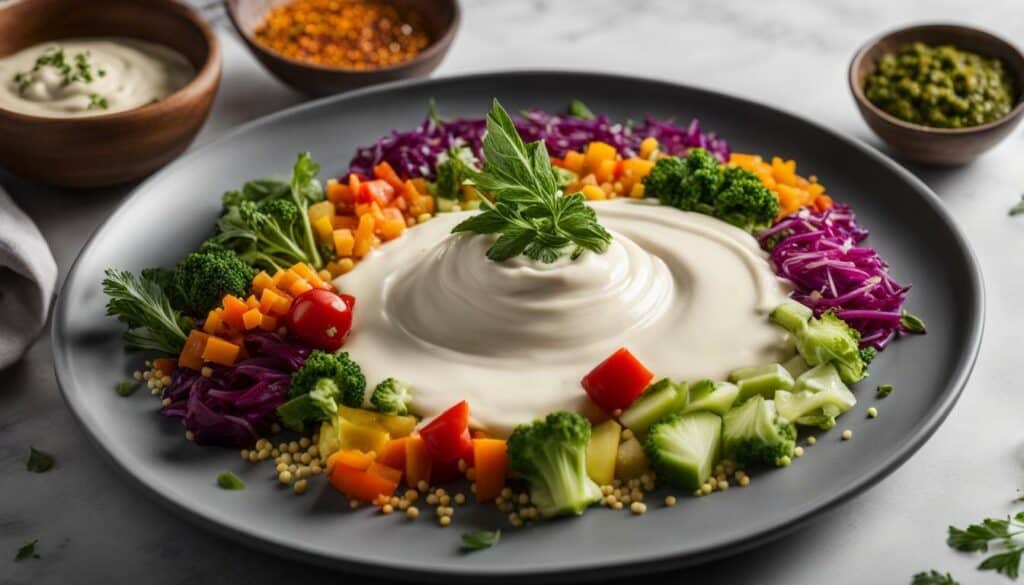
| Sauce | Serving Size | Calories (kcal) | Fat (g) | Sugar (g) | Salt (g) |
|---|---|---|---|---|---|
| Reduced-Sugar White Sauce | 1 serving (2 tbsp) | 35 | 2.5 | 1 | 0.5 |
| Reduced-Salt White Sauce | 1 serving (2 tbsp) | 30 | 2 | 0.5 | 0.3 |
Low-Calorie White Sauce Recipes
Craving white sauce but want to keep the calorie count in check? Try these delicious low-calorie white sauce recipes that will satisfy your taste buds without adding extra inches to your waistline.
1. Greek Yogurt White Sauce
Ingredients:
- 1 cup plain Greek yogurt
- 2 tablespoons lemon juice
- 1 clove garlic, minced
- Salt and pepper to taste
Instructions:
- In a small bowl, combine the Greek yogurt, lemon juice, garlic, salt, and pepper.
- Whisk until well combined and smooth.
- Use as a healthy substitute for traditional white sauce in your favorite recipes.
2. Cauliflower Alfredo Sauce
Ingredients:
- 1 head cauliflower, cut into florets
- 2 cloves garlic, minced
- 1 cup low-sodium vegetable broth
- ¼ cup grated Parmesan cheese
- Salt and pepper to taste
Instructions:
- Steam the cauliflower florets until tender.
- In a blender, combine the steamed cauliflower, garlic, vegetable broth, Parmesan cheese, salt, and pepper.
- Blend until smooth and creamy.
- Use as a healthier alternative to traditional white sauce in pasta dishes or as a dip.
3. Low-Fat Bechamel Sauce
Ingredients:
- 2 tablespoons unsalted butter
- 2 tablespoons all-purpose flour
- 1 cup low-fat milk
- Salt and pepper to taste
Instructions:
- In a saucepan, melt the butter over medium heat.
- Add the flour and whisk until smooth.
- Gradually add the milk, whisking continuously until the sauce thickens.
- Season with salt and pepper.
- Use as a lighter version of traditional white sauce in casseroles, lasagna, or gratin dishes.
| Recipe | Serving Size | Calories per Serving |
|---|---|---|
| Greek Yogurt White Sauce | 2 tablespoons | 25 |
| Cauliflower Alfredo Sauce | ¼ cup | 45 |
| Low-Fat Bechamel Sauce | 2 tablespoons | 40 |
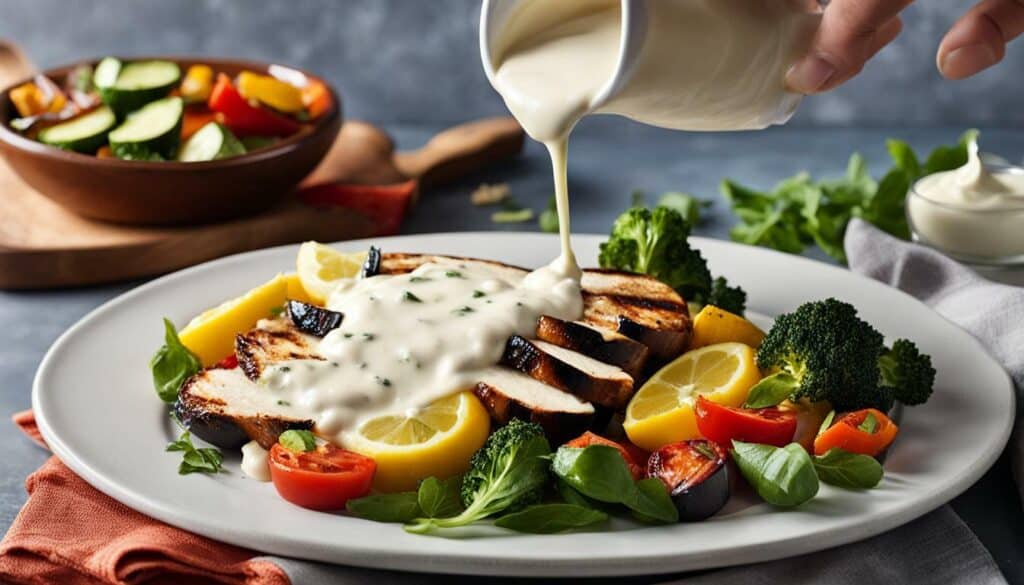
Alternatives to High-Calorie White Sauce
If you’re looking for a lighter and healthier alternative to high-calorie white sauce, these low-calorie substitutes will give your dishes the same creamy goodness without the guilt. Whether you’re watching your calorie intake or simply want to make healthier choices, these options will not disappoint.
Light White Sauce
One great alternative to high-calorie white sauce is a light version that uses low-fat ingredients. By substituting whole milk or cream with skim milk or a low-fat alternative, you can significantly reduce the calorie content without sacrificing taste. This lighter option still provides the creamy texture and flavor you love, but with fewer calories and less fat.
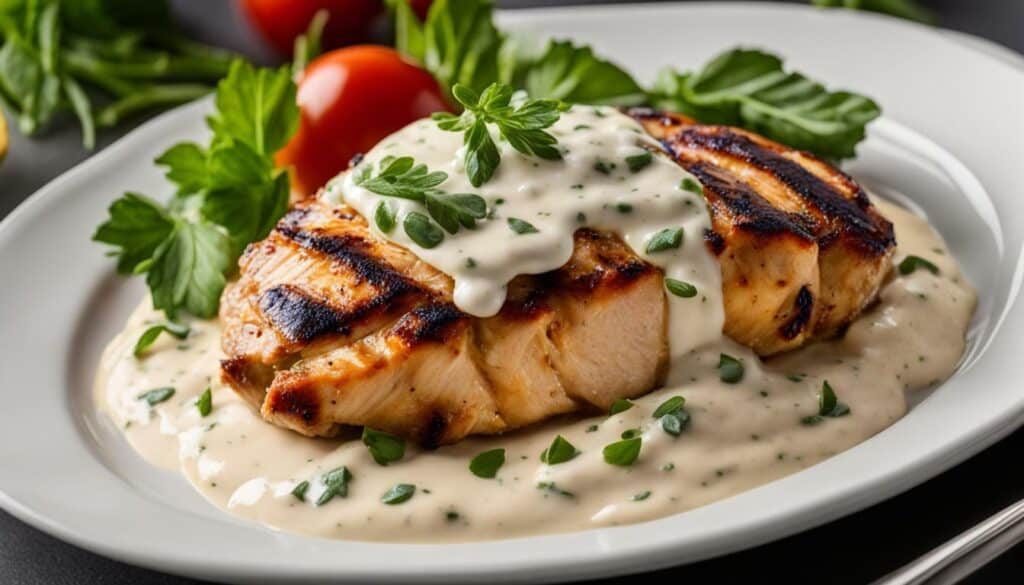
Low-Fat White Sauce
If you’re looking for an even lower-calorie option, consider using a low-fat white sauce. This version typically replaces butter with a healthier fat alternative, such as olive oil or vegetable oil. By reducing the fat content, you can enjoy white sauce with significantly fewer calories. So go ahead and pour it over your favorite dishes guilt-free!
When it comes to making healthier choices, there are plenty of low-calorie white sauce substitutes to choose from. Whether you opt for a light version or a low-fat alternative, these options will help you stay on track with your dietary goals without compromising on flavor. So why wait? Start experimenting with these alternatives and discover a whole new world of delicious, guilt-free creamy goodness!
Making White Sauce Healthier at Home
Transform your favorite white sauce into a healthier version by following these simple tricks and techniques that will help you cut down on calories and fat without compromising on taste.
First, consider using low-fat ingredients in your homemade white sauce. Replace full-fat milk or cream with skim milk or alternative milk options like almond or oat milk. You can also substitute butter with low-fat margarine or olive oil to reduce the overall fat content.
To further decrease the calorie count, try using low-carb alternatives in your white sauce recipe. Replace traditional flour with almond flour or cornstarch for a thickening agent that has fewer carbs. You can also experiment with adding flavorful herbs and spices, like garlic, thyme, or paprika, to enhance the taste without adding extra calories.

In addition, portion control plays a crucial role in managing the calorie content of your white sauce. Instead of drowning your dishes in a pool of sauce, try drizzling a smaller amount over your food, or use a measured amount to ensure you’re not overindulging.
By implementing these tips and techniques, you can enjoy a healthier version of white sauce that satisfies your cravings while supporting your diet goals. So go ahead and get creative in the kitchen, and let your taste buds savor a guilt-free white sauce experience!
The Role of Tomato-Based Sauces in Calorie Management
Looking for a low-calorie alternative to creamy white sauce? Tomato-based sauces not only add a burst of flavor to your dishes but also help you keep your calorie count in check. Whether you’re watching your weight or simply looking for healthier options, incorporating tomato-based sauces into your meals can be a delicious and nutritious choice.
The Benefits of Tomato-Based Sauces
Tomato-based sauces, such as marinara, salsa, or tomato puree, are made primarily from tomatoes, which are low in calories and high in essential nutrients. Tomatoes are packed with vitamins A, C, and K, as well as potassium and dietary fiber. These nutrients play a crucial role in supporting overall health and well-being.
Additionally, tomato-based sauces are naturally low in fat and cholesterol-free, making them a heart-healthy option. They provide a vibrant color and tangy taste to your dishes while offering a range of health benefits.
Recipe Inspiration: Tomato-Based Sauces
Here’s a simple recipe to get you started with a delicious and low-calorie tomato-based sauce:
| Ingredients | Amount |
|---|---|
| Tomatoes (diced) | 4 cups |
| Onion (chopped) | 1 medium |
| Garlic cloves (minced) | 2 |
| Olive oil | 1 tablespoon |
| Dried basil | 1 teaspoon |
| Dried oregano | 1 teaspoon |
| Salt and pepper | To taste |
Instructions:
- In a large saucepan, heat olive oil over medium heat. Add onions and garlic, and sauté until translucent.
- Add diced tomatoes, basil, oregano, salt, and pepper. Stir well to combine.
- Reduce heat to low, cover, and simmer for 30 minutes, stirring occasionally.
- Use an immersion blender or transfer the mixture to a blender to achieve the desired consistency. Blend until smooth.
- Adjust seasoning to taste and enjoy your homemade, low-calorie tomato-based sauce!
Remember, tomato-based sauces are versatile and can be used in a variety of dishes, from pasta to casseroles and even as a dipping sauce for vegetables. Get creative in the kitchen and explore the endless possibilities that these flavorful sauces have to offer.
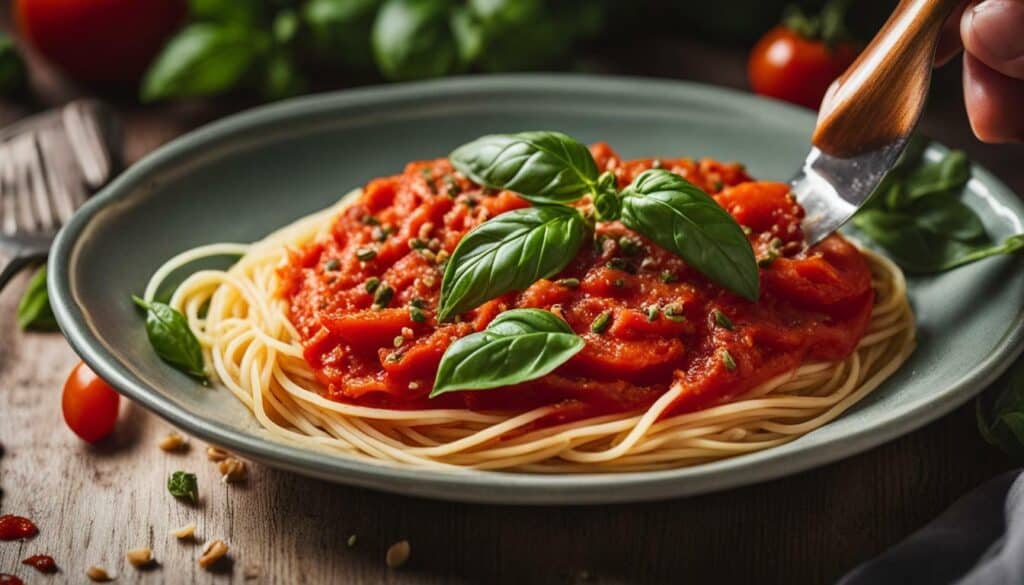
So, the next time you crave a creamy white sauce, consider switching it up with a tomato-based alternative. Your taste buds and your waistline will thank you!
Pairing White Sauce with Low-Calorie Foods
Enhance your white sauce dishes with a variety of nutritious and low-calorie foods that will not only add flavor but also help you achieve your weight loss goals. By incorporating these healthy options into your meals, you can create satisfying and guilt-free dishes that are both delicious and nourishing.
One way to lighten up your white sauce dishes is by incorporating an array of colorful vegetables. Vegetables like broccoli, cauliflower, and Brussels sprouts are low in calories and high in fiber, making them great choices for weight loss. Not only do they add texture and crunch to your dishes, but they also provide essential vitamins and minerals.
In addition to vegetables, fruits can also be a fantastic addition to white sauce dishes. Fruits like apples, papaya, and grapefruit are low in calories and high in antioxidants, which can help support your overall health. Their natural sweetness can also help balance the creaminess of the sauce while adding a burst of flavor.
To create a well-rounded and nutritious meal, consider pairing your white sauce dishes with lean protein sources. Fish like salmon or grilled chicken breast are excellent options, as they are low in calories and rich in essential amino acids. These proteins not only help keep you satisfied but also support muscle growth and repair.
| Low-Calorie Foods |
|---|
| Apples |
| Broccoli |
| Brussels sprouts |
| Cauliflower |
| Grapefruit |
| Papaya |
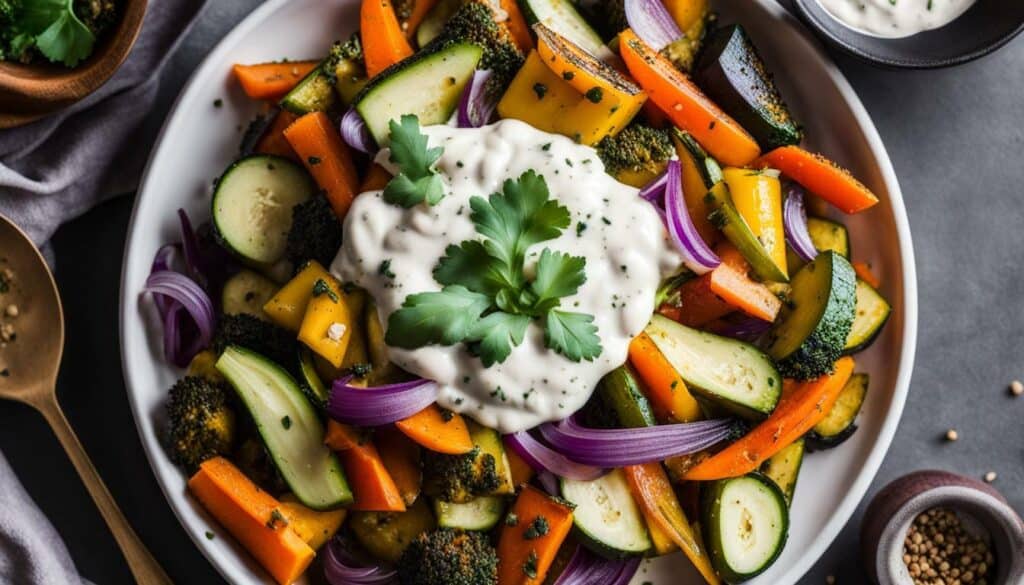
Adding a variety of low-calorie foods to your white sauce dishes not only adds nutritional value but also helps create a balanced and satisfying meal. Don’t be afraid to experiment with different combinations and flavors to find what works best for you and your taste buds.
Remember, the key to achieving healthy weight loss is not just about counting calories, but also making nutrient-rich choices. By opting for low-calorie foods and pairing them with white sauce, you can enjoy a satisfying meal that supports your weight loss goals while still indulging in your favorite flavors.
The Nutritional Value of Low-Calorie Foods
Not only are low-calorie foods great for weight management, but they also offer a range of essential nutrients and beneficial plant compounds that are vital for optimal health. These nutrient-rich foods should be a staple in any balanced diet, as they provide a variety of vitamins, minerals, and antioxidants that support overall well-being.
When it comes to incorporating low-calorie foods into your meals, there are plenty of options to choose from. Fruits and vegetables are excellent choices, as they are naturally low in calories and high in fiber, which promotes satiety and aids in digestion. In addition, they are packed with vitamins and minerals, such as vitamin C, potassium, and folate, which are essential for various bodily functions.
Some examples of low-calorie fruits and vegetables include apples, arugula, asparagus, beets, broccoli, Brussels sprouts, cabbage, carrots, cauliflower, celery, chard, clementines, cucumbers, fennel, grapefruit, iceberg lettuce, jicama, kale, white mushrooms, onions, peppers, papaya, radishes, tomatoes, and zucchini. Incorporating these foods into your daily meals can add color, flavor, and nutritional value while helping you maintain a healthy weight.
| Fruit | Calories (per 100g) | Nutrients |
|---|---|---|
| Apple | 52 kcal | Packed with fiber and vitamin C |
| Grapefruit | 32 kcal | Rich in vitamin C and antioxidants |
| Clementines | 47 kcal | High in vitamin C and fiber |
| Papaya | 43 kcal | Contains vitamin C, folate, and potassium |
These low-calorie foods provide a wealth of nutrients while keeping your calorie intake in check. By incorporating them into your meals and snacks, you can create a well-rounded and satisfying diet that promotes overall health and weight management.
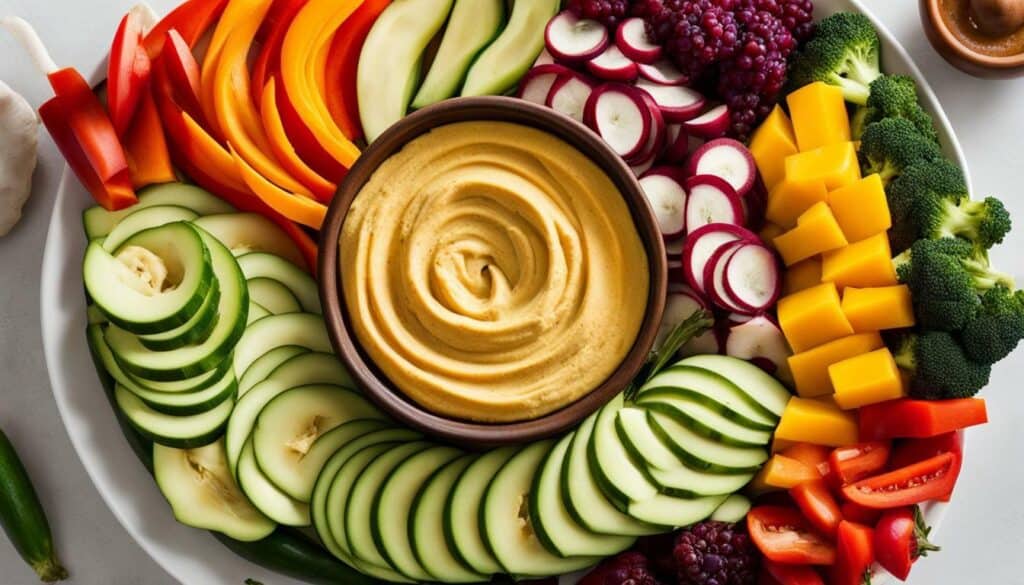
Indulging in white sauce doesn’t have to derail your diet. By adopting mindful eating practices, you can savor the deliciousness while still staying on track with your nutritional goals.
When enjoying white sauce, it’s important to practice portion control. Instead of slathering your entire plate with sauce, try using a smaller amount and spreading it evenly to enhance the flavor. Remember, a little goes a long way!
Another tip for mindful eating is to slow down and savor each bite. Take the time to appreciate the taste, texture, and aroma of your dish. This not only helps you fully enjoy your meal but also allows your brain to register feelings of satiety, preventing overeating.
Incorporating healthy ingredients into your white sauce can also make it a more nutritious choice. Consider adding veggies like spinach, mushrooms, or bell peppers to boost the fiber and nutrient content. You can even experiment with using Greek yogurt instead of heavy cream for a lighter yet still creamy texture.

By practicing mindful eating and making conscious choices when it comes to white sauce, you can relish in its savory goodness without compromising your health or weight loss goals. Remember, it’s all about finding balance and enjoying your meals in a way that nourishes both your body and soul.
Conclusion
Counting white sauce calories and making healthier choices can keep you on the right track towards achieving your diet goals without sacrificing flavor and enjoyment. When it comes to white sauce, being mindful of the fat, sugar, and salt content is crucial. Instead of using high-sugar ketchup, consider opting for reduced-sugar versions or making your own salsa. Similarly, swap calorie-dense mayonnaise for reduced-fat options or make a lighter version with low-fat yogurt. Soy sauce, known for its high salt content, should be used sparingly, even with reduced-salt versions. If you love sweet chili sauce, try making your own without the added sugar for a healthier alternative.
Mustard is relatively low in fat and sugar, but it’s important to check labels for salt content. Pesto, while delicious, can be high in calories and fat, so consider opting for reduced-fat varieties or making your own with olive oil and fresh basil. Brown sauce, often enjoyed with savory dishes, contains added sugar and salt. Choosing reduced-sugar and reduced-salt versions can help in making healthier choices.
When it comes to cooking sauces, tomato-based options are generally healthier than creamy ones. By making the switch, you can save on calories and reduce saturated fat. Additionally, pairing calorie-dense foods with lower-calorie options such as fruits and vegetables can make your meals more satisfying and support healthy weight loss. There are many low-calorie foods to choose from, including apples, arugula, asparagus, beets, broccoli, Brussels sprouts, cabbage, carrots, cauliflower, celery, chard, clementines, cucumbers, fennel, grapefruit, iceberg lettuce, jicama, kale, white mushrooms, onions, peppers, papaya, radishes, tomatoes, and zucchini. These foods not only have fewer calories but are also packed with nutrients and beneficial plant compounds.
FAQ
Q: How can I count white sauce calories?
A: To count white sauce calories, you need to be mindful of the fat, sugar, and salt content. Pay attention to the nutritional information on the packaging or use online resources to calculate the calories in each tablespoon of white sauce.
Q: Is ketchup a healthy option for white sauce?
A: Ketchup contains 0.3g of salt and 4.1g of sugar per tablespoon, so it’s not the healthiest option. Opting for reduced-sugar versions or making your own salsa can be a healthier choice.
Q: How many calories are in mayonnaise?
A: Mayonnaise is high in calories and fat, with each tablespoon containing around 104kcal and 11.3g of fat. Opting for reduced-fat options or making a lighter version with low-fat yogurt can save calories.
Q: Is soy sauce a healthy choice for white sauce?
A: Soy sauce is high in salt, so it’s important to use it sparingly, even with reduced-salt versions.
Q: How can I make a healthier chili sauce?
A: Sweet chili sauce is packed with sugar. Making your own chili sauce without sugar can be a healthier alternative.
Q: Is mustard a low-calorie option for white sauce?
A: Mustard is relatively low in fat and sugar, but some brands may contain more salt than others.
Q: Is pesto a healthy choice for white sauce?
A: Pesto is high in calories and fat. Opting for reduced-fat versions or making your own with olive oil and fresh basil can be a healthier option.
Q: Is brown sauce a healthy option for white sauce?
A: Brown sauce contains sugar and salt. Opting for reduced-sugar and reduced-salt versions is a better choice.
Q: Are ready-made cooking sauces healthy?
A: Ready-made cooking sauces can vary in nutritional content, but tomato-based sauces are generally healthier than creamy ones. Swapping creamy sauces for tomato-based ones can save calories and saturated fat.
Q: How can I make my white sauce meals more satisfying?
A: Pairing calorie-dense foods with lower-calorie ones, such as fruits and vegetables, can make meals more satisfying and promote healthy weight loss. Some low-calorie foods include apples, arugula, asparagus, beets, broccoli, Brussels sprouts, cabbage, carrots, cauliflower, celery, chard, clementines, cucumbers, fennel, grapefruit, iceberg lettuce, jicama, kale, white mushrooms, onions, peppers, papaya, radishes, tomatoes, and zucchini. These foods are not only low in calories but also rich in nutrients and beneficial plant compounds.
How Many Calories Are in Red Mango’s Healthier Choices Compared to White Sauce?
If you’re curious about the number of calories in Red Mango’s healthier choices compared to their white sauce, the red mango calorie guide is your go-to resource. It provides detailed information on the calorie content of their various options so you can make informed decisions. Keep the guide handy to keep a track of your calorie intake.





Leave a Reply